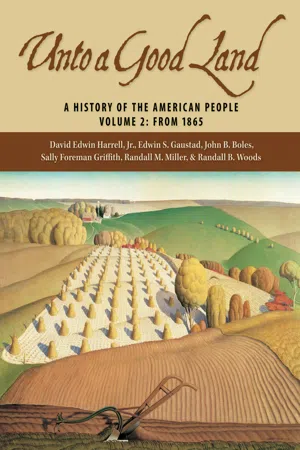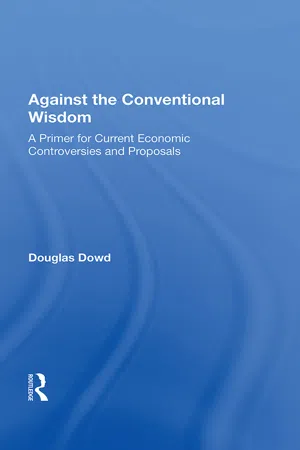History
Square Deal
The Square Deal was a domestic program introduced by President Theodore Roosevelt in the early 20th century. It aimed to strike a balance between the interests of labor, business, and the public by promoting fair treatment, conservation of natural resources, and regulation of big business. The Square Deal sought to address social and economic inequalities through progressive reforms.
Written by Perlego with AI-assistance
Related key terms
4 Key excerpts on "Square Deal"
- eBook - ePub
Reconsidering American Liberalism
The Troubled Odyssey Of The Liberal Idea
- James Young(Author)
- 2018(Publication Date)
- Routledge(Publisher)
Moreover, there is no reason to doubt the sincerity of the president in trying to establish the fact that he did not intend to deal with a banker like J. P. Morgan as a coequal potentate. At the same time, Roosevelt's actions were not in any sense part of an assault on the concentrated power of big business as such. In the 1910 speech at Ossowatamie in which he began his insurgency against the Republican establishment, Roosevelt made it clear, saying, "Combinations in industry are the result of an imperative economic law which cannot be repealed by political legislation." Prohibition of combinations had failed; the only hope was to control them in the public interest. 14 Rather too easily wrapping himself in the mantle of Abraham Lincoln, Roosevelt argued that although labor was prior to and independent of capital, nevertheless capital too had its rights. 15 America had to free itself from special interests, work for genuine equality of opportunity, and accept a legitimate role for the state in regulating the economy. That was the path to the "Square Deal." That speech gave the essence of the New Nationalism, which Roosevelt pursued, in and out of office, throughout his career in national politics. For a more fully developed version of his ideas, we can turn to the influential 1909 book by the journalist Herbert Croly, The Promise of American Life. 16 Croly, who, along with Walter Weyl and Walter Lippmann, founded an influential weekly journal of opinion, the New Republic, in 1914, was the product of a somewhat prolonged and checkered career at Harvard, where he studied in the golden age of American philosophy under Josiah Royce, George Santayana, and William James - eBook - ePub
Unto a Good Land
A History of the American People, Volume 2: From 1865
- David Edwin Harrell, Edwin S. Gaustad, John B. Boles, Sally Foreman Griffith(Authors)
- 2005(Publication Date)
- Eerdmans(Publisher)
Muller v. Oregon, the Supreme Court upheld an Oregon law limiting the working hours of women. Attorney Louis Brandeis (who would later become a distinguished Supreme Court justice) defended the Oregon law with statistical, historical, economic, and sociological data rather than traditional legal precedents. This “Brandeis brief” opened a new era of legal argument for social legislation.Roosevelt’s actions in the Northern Securities case and the coal strike endeared him to much of the public as a trustbuster. In fact, the president was no doctrinaire radical, nor was he overly fond of organized labor. In later years, union supporters often accused Roosevelt of being anti-union. The only clear messages in the president’s early actions were that he demanded fairness in class disputes, or a “Square Deal” as he called it, and that he would use the government against powerful interests when they threatened the nation’s democratic ideals.Political Victory and the Square Deal
Roosevelt was preoccupied during his first term with ensuring that his party would nominate him for a second term. (At the time, such nomination was not a foregone conclusion. All previous vice presidents—Tyler, Fillmore, Andrew Johnson, and Arthur—who had been vaulted into the White House by their predecessor’s death were denied their party’s subsequent nomination for the presidency.) His chief competitor within the Republican Party was Senator Mark Hanna of Ohio, who coveted the presidency. But Hanna’s sudden death in 1904 removed all obstacles, and Roosevelt was unanimously nominated at the Republican convention.Progressive-Era Class War A fist, punching through from the lower depths, sends a shockwave through a crowd of carefree plutocrats in this dramatic turn-of-the-century image, warning of dire social conflicts ahead if calls for reform were not heeded.A badly divided Democratic party nominated little-known New York Supreme Court justice Alton B. Parker to run against Roosevelt in 1904. A lackluster candidate with a conservative record, Parker was no match for the charismatic Roosevelt. TR won in a landslide, with a popular vote of 7.6 million to Parker’s 5.1 million, and the Republicans gained majorities in the Senate and the House. On the evening of his victory, the elated Roosevelt announced to the press that “under no circumstances will I be a candidate for or accept another nomination.” He would later regret it. - eBook - ePub
Against the Conventional Wisdom
A Primer For Current Economic Controversies And Proposals
- Douglas Dowd(Author)
- 2019(Publication Date)
- Routledge(Publisher)
10 Needs and PossibilitiesToward a Square Deal
Echoing the New Deal of FDR and the Fair Deal of Harry S. Truman, Adlai Stevenson—running for president against Eisenhower (and losing to him twice in the 1950s)—saw Ike’s first term as a “big deal” and the White House as staffed mostly by “used car dealers.” After Nixon had been in office a while, his policies came to be dubbed the “raw deal.” And that’s what most Americans have had ever since from the wheelers and dealers who have increasingly dominated our social process.Now the time is overdue for something very different from any of those “deals.” We need a socioeconomic program that has the well-being of the overwhelming majority of our people and of the earth as its direct focus: a Square Deal—no more trickle down, no more pie in the sky, no more jiggerypokery. Too many millions have been too badly damaged by the failed promises of those years; the society can’t afford it any more—if it ever could.But we cannot become a just and sane society easily or quickly. There is too much debris to be cleared away, too much that is new to us to be constructed. The cleaning up and the new construction will not be done by those who have made it necessary. Those who hold economic, political, and social power will not change their ways; they must be dislodged—a difficult job, but not without a modest precedent or two, as recently as the 1960s. After that brief period of minimal power sharing, the nation resumed its march toward a greater concentration of power. It should come as no surprise that the power has been used to the rising benefit of those who hold it, at the cost of an always higher percentage of Americans.Put differently, it should be clear that substantial socioeconomic betterment for those outside the charmed circle of power must be wrought by them. That requires much more thought and political work than usual by the ordinary people of this society; it means much changing of the mind about social causes and effects, doing that “more political work” with ordinary people like ourselves, trusting one another more and trusting less those who time and again have betrayed the trust they were granted. A government for the people quite literally must be of and by - eBook - ePub
American Stories
Living American History: v. 2: From 1865
- Jason Ripper(Author)
- 2015(Publication Date)
- Routledge(Publisher)
5A Palette of Progressives
W.E.B. DuBois (C.M. Battey/Getty Images)The “Full Dinner Pail” and the “Square Deal”: Theodore Roosevelt as President
During his successful presidential campaign in 1900, William McKinley and his vice presidential running mate, Theodore Roosevelt, assured the electorate a “full dinner pail,” plenty of food to eat along with all the other trimmings of prosperity. In 1904, voters elected Theodore Roosevelt president after he offered them a “Square Deal,” a slogan less well dehned than a table spread with food, but seeming nevertheless to promise the sort of fairness and good-governance upon which Roosevelt staked his reputation. How well did he deliver?In 1900 there were 8,000 automobiles registered in the United States. By 1910, there were 458,000 registered automobiles. The dragging farm prices of the 1890s had rebounded, and the average wage earner saw about a 20 percent increase in wages over that same time, up to about $600 annually. Electricity continued to fan out from cities to suburbs, though most rural areas would have to wait until the 1930s and 1940s for electric power. Starting in 1907, well-funded government specialists trained to weed out diseased meats and dangerous drugs began inspecting food and pharmaceuticals. During a 1902 strike for higher wages, the federal government supported Pennsylvania coal miners. First in Wisconsin, and then elsewhere in the Midwest and West, legislatures wrote new forms of direct political action into law—referendums, initiatives, primaries, and recalls—giving voters the chance to vote on laws, propose new laws, choose candidates for elective office, and yank politicians out of office. And there was more fun to be had in America, too.Bicycles by the millions whirred over brick roads and country lanes. Innovative diamond-shaped frames and improved tires provided the convenience and comfort needed to get women riding, even in a skirt. Susan B. Anthony, the famous suffragist also famous for her stick-in-the-mud seriousness, said bicycles had “done a great deal to emancipate women. I stand and rejoice every time I see a woman ride by on a wheel.”1 The leader of the Women’s Christian Temperance Union, Frances Willard—noted for her sparkling advocacy of a dry country—got such a boost from bicycle riding that she promoted its delights in an 1895 book, A Wheel Within a Wheel: How I Learned to Ride the Bicycle . Willard was sure that if women catapulted themselves onto the backs of bikes, they could also spin a proper campaign to attain full citizenship, namely the right to vote. She remembered being imprisoned by apparel on her sixteenth birthday, “the hampering long skirts … with their accompanying corset and high heels; my hair was clubbed up with pins.” Dutiful to tradition, Willard stayed “obedient to the limitations thus imposed” by stifling clothes and inhibiting expectations, but almost four decades later, overwhelmed by overwork and grief for her mother’s death and needing “new worlds to conquer, I determined that I would learn the bicycle.” What started out as an energizing diversion soon became a means to convey her messages: “I also wanted to help women to a wider world, for I hold that the more interests women and men can have in common, in thought, word, and deed, the happier will it be for the home. Besides, there was a special value to women in the conquest of the bicycle by a woman in her fifty-third year.”2
Index pages curate the most relevant extracts from our library of academic textbooks. They’ve been created using an in-house natural language model (NLM), each adding context and meaning to key research topics.



